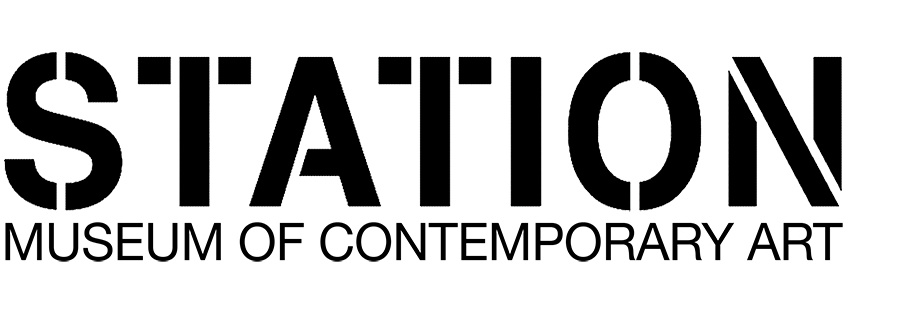
- 1502 Alabama St.
- Houston, TX 77004
- USA
- 713-529-6900
- station.museum.houston.tx@gmail.com
- Closed Monday & Tuesday
- Open Wednesday - Sunday, 12PM - 5PM
- Free Admission!


The will to power not a being, not a becoming, but a pathos – the most elemental fact from which a becoming and effecting first emerge.
Nietzsche
POWER PATHOS is an exhibition of the work of five artists, Ron English, Clark Fox, Gibby Haynes, Daniel Johnston and Anthony Ausgang, who have deep Texas roots. As an exhibition it is a contribution to a contemporary art movement that is rapidly becoming the mainstream for a growing number of young artists who are responding to the blitzkrieg of mass culture on their lives.
Originating in the early 1990s (the end of the Cold War and the true beginning of the 21st century) this movement has appeared in several guises: Lowbrow/Pop Surrealism, Acid Pop, Massurealism, and Nobrow. To our mind, Pop Surrealism is the most apt. It identifies this new approach as the leading edge of a continuum from historical Surrealism to the present.
Pop Surrealism is working class, anarchist, and populist; at the same time, it communicates a radical post-Freudian, confessional psychology. Its references and subject matter – comics, graffiti art, outsider art, billboards, car art, rock music, street culture, pop stars and pop presidents – may converge in the work of each artist, but this convergence gives way to an outrageous sense of independence. The central focus is on transforming popular cultural, political, commercial images and personal experience into subversive, psychologically intense expressions of the human psyche. Pop Surrealism attests to the power of weltschmertz, an amalgam of sorrow, pain, rage, and dark or black humor.
Either reinventing, modifying, or stealing popular material outright to suit their social, political or aesthetic purposes or creating new images, the artists’ objective is not only to free themselves and their viewers from the delimiting and stultifying effects of religious, commercial and political propaganda but also to rescue the imagination itself from its evident decline in American life.
Power Pathos is an affirmation of Pop Surrealism. It is one of the few museum exhibitions to recognize its importance as a 21st century movement. In an era of widespread disinformation, social and spiritual unrest, the five artists in the exhibit can be seen as the modern archetypes of the eternally independent spirit. Other artists, such as, Robert Williams, Mark Ryden, Camile Rose Garcia, Sas Christian, Lori Early, and Todd Shorr have made significant contributions to the movement but as yet have received little museum recognition. Like the artists in Power Pathos, they probe the relationship between consumerism and its pathological effect on contemporary consciousness.
– James Harithas
The curators of the exhibit are Alan Schnitger, Jordan Poole, and Clark Fox who helped organize the exhibition from its inception.
[supsystic-gallery id=8]
Ron English, outlaw ad-man of alternative culture, is as well known for his surreal paintings as he is for his exploits in pirating public billboards. He hijacks Western art forms, pop culture and corporate America’s advertisements by transforming consumer icons into profoundly satirical, personal symbols. He thereby disrupts the privatization of metropolitan iconography, i.e., signs, billboards, corporate logos, and in doing so, he obviates and loosens the grip that such imagery has on our lives.

Ron English, Liberated billboard Houston, TX 2006
English’s work regularly features his children as models to create the complex running narratives of his many alter egos. With these multiple personas in his arsenal, he challenges the grand illusion of the “American Dream,” exposing, analyzing and overturning the cultural norms, which influence and corrupt many aspects of American life.
During the weeks prior to the opening of Power Pathos, Ron English tirelessly worked at the Station Museum to produce his most accomplished painting.
GRADE SCHOOL GUERNICA
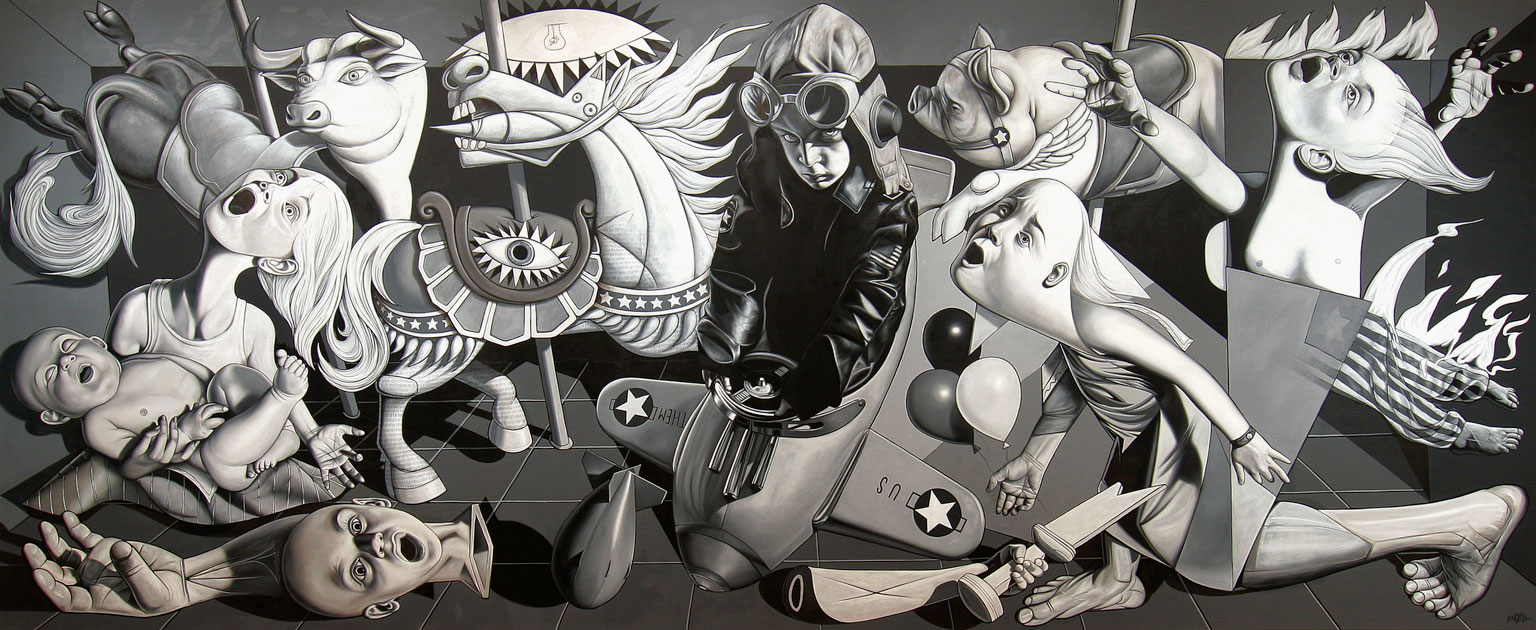
Ron English, “GRADE SCHOOL GUERNICA”, 2006, oil on canvas, 27’ x 11’
A foot larger than the original, transforms Guernica into a child’s game complete with merry-go-round animals and children in various states of alarm. Ron English has recreated an icon of the horrors of war of the twentieth century, making it into an active symbol of the twenty-first century’s mass civilian casualties, particularly children.
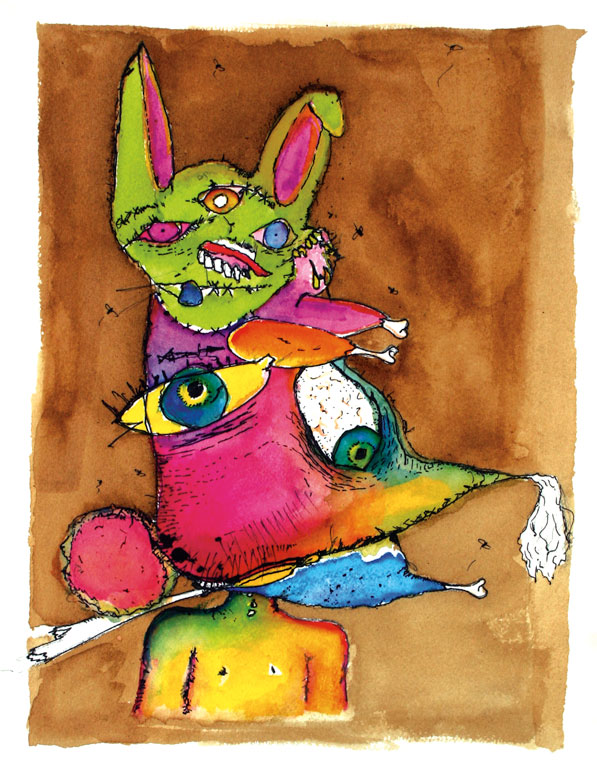
Gibby Haynes, “CHICKEN FRIED BUNNY”, 2006, mixed media on paper 11” x 13”
Anyone with a flair for the bizarre, anybody who’s been charmed and romanced by a lurking weirdness, anyone clamoring to rant off life’s brevity, will find no trouble identifying with Gibby Haynes’s brash insights and pleasantly perverse illustrations.
Haynes, the former front-man of the legendary Butthole Surfers, reworks the linear strings of reality through the subconscious contours of surrealism. Paranoia, obsession and caution collide in the work, but yield to the vitality and élan needed to pursue a deeper, more intricate understanding of our surroundings. The result is a stream-like consciousness of binary counterparts – of what we see and think and of what we are shown and told.
While cutting cereal boxes into strips for Burning Poppies, an installation consisting of around 150 boxes of Pops, Smacks, Frosted Flakes, Kix, etc., Haynes derided manufacturers for loading these products with sugar. “Man, that’s a ton of sugar,” Haynes exclaimed between handfuls of Pops. “I loved this stuff as a kid.” His snacking beautifully critiques the American life of indulgence, a life of sex, drugs, alcohol, lunacy, sugar, and mindless cultural imagery.
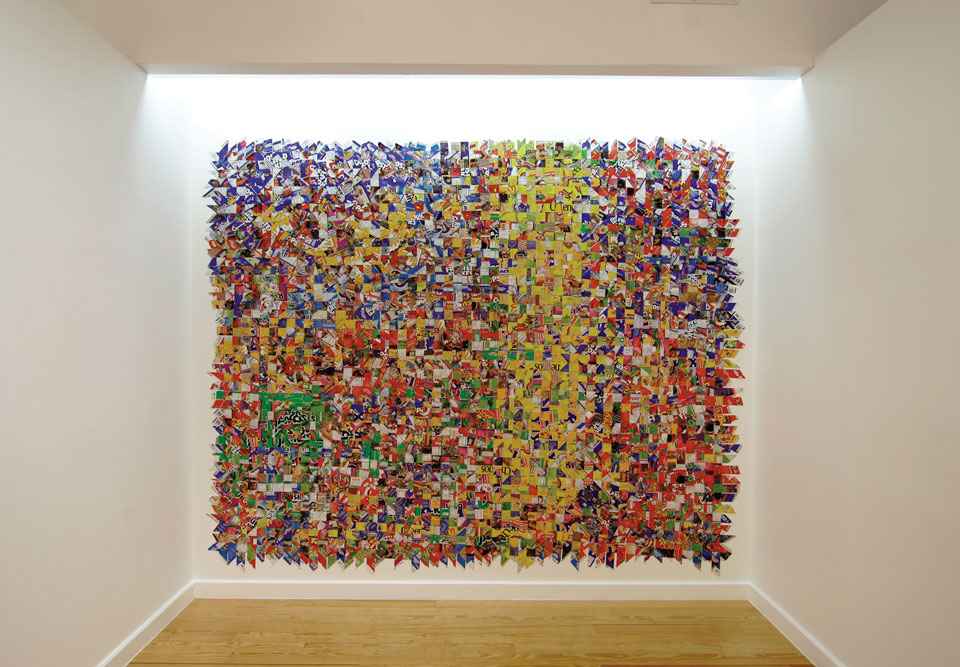
Gibby Haynes, “BURNING POPPIES”, 2006, approx. 150 cereal boxes, 8’ x 10’
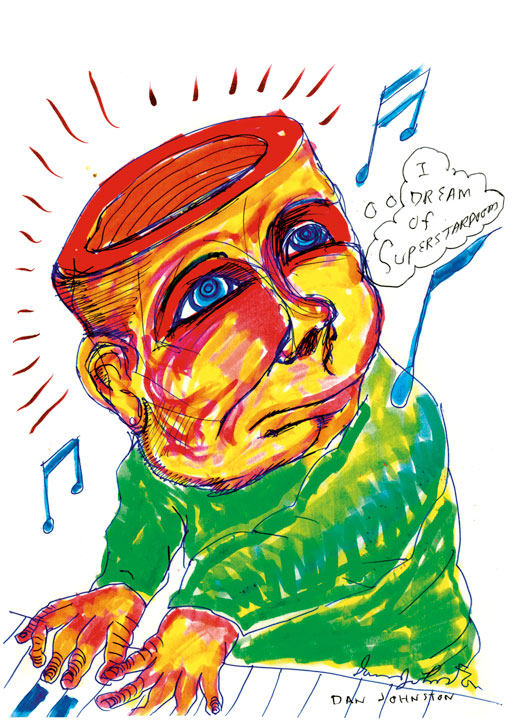
Daniel Johnston, “I DREAM OF SUPERSTARDOOM”, c. 1978, ink on paper, 8.5” x 11” Collection of Marjory Johnston
Daniel Johnston’s drawings resonate like the plaintive wailing of a wounded superhero. Inspired by generations of comic books, the unabashedly honest work of this artist mirrors the imperfections and the capricious idiosyncrasies of life. Comics provide Johnston with a suitable rhetoric for his struggle to deal conceptually with the oppositions and divisions of good and evil.
Perhaps better known as the pied piper of the American underground, this musical genius began his storied career as a visual artist. The themes of unrequited love, rejection, spirituality, and childhood, which Johnston explores in his famous songs, are given visual form in his art. If his music has been the soundtrack for a disaffected generation, then his drawings are the storyboard for the movie in Johnston’s mind, and with a little imagination, even the movie in our own collective consciousness.
Johnston’s drawings are true madness and are absolutely beautiful in that. What often resembles grade school binder art is in reality a vernacular of ink and markers, of unease and confidence, and, to borrow a title from the writer Yasunari Kawabata, of Beauty and Sadness. Through his art, he articulates the insurmountable pain of his own existence with the metonymies of adolescent pop mythology. His drawings are a revelation of integrity because they are a direct and unambiguous expression of his life experiences.
Few, if any, have followed his path, leaving him the lone voice in a wilderness of his own creations – guileless conjunctions of youth and familiarity, where the demarcations are defined by his drawings and songs, where each advance both embraces the past and then lets go. We should all be thankful for Johnston and for the benefit of such an inimitable and innocent display of self-discernment.
I consider the development of cartoon animals the same way I regard human evolution; it was the cats that first crawled out of the primordial ink and morphed themselves erect on hind legs… by using animals, I can avoid the interpretations one gets by using human figures.
Anthony Ausgang
Anthony Ausgang belongs to the first generation parented by Saturday morning color television. Cartoons have allowed him to create uninhibited social narratives animated by popular art’s purity of color and the rhythmic ballet of personal expressionism.
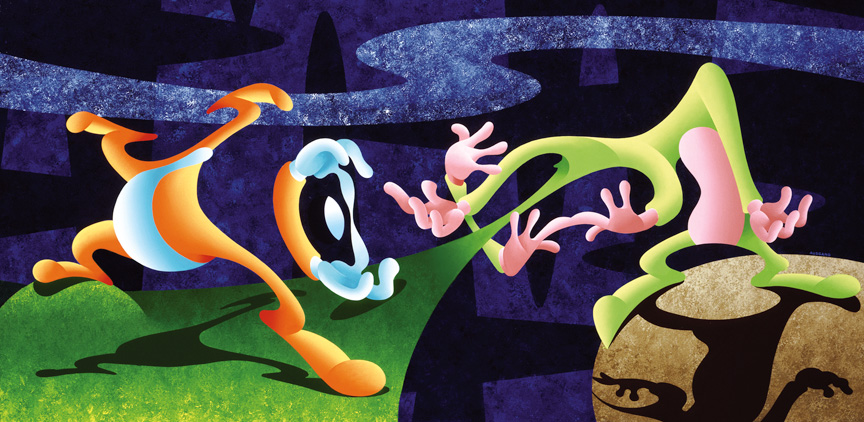
Anthony Ausgang, “THE CARTOON CREATIONIST”, 2006, acrylic on canvas, 79” x 42”
The expanse of possibility in Ausgang’s work succeeds because the heavy hand of point blank realism does not distract us. Instead, Ausgang puts in front of us paintings which characterize the collective experience through animation.
The history of our times calls to mind those Walt Disney characters who rush madly over the edge of a cliff without seeing it, so that the power of their imagination keeps them suspended in mid-air; but as soon as they look down and see where they are, they fall.
Raoul Vaneigem, The Revolution of Everyday Life
In Ausgang’s work the cat is the dominant actor. The cat is master of his amorphous environment and becomes the vessel of all the ambition, emotion, rationality and desire that humans have traditionally regarded as their evolutionary reward. Is the cat anthropomorphic, serving as a stand-in for humanity, or then again, maybe not? In Ausgang’s universe the human does not even hold the status of pet. The human holds the ultimate outsider status – nonexistence.
Using appropriated corporate and political icons, Clark Fox dismantles the effects of capitalist culture on our consciousness. In his art, Fox explores the basic components of visual expression in order to redefine our understanding of social and political identity.
Clark’s trademarked character is Mr. Peanut, the early twentieth century iconic image of the capitalist shill, one which is reemployed by the artist to explore class distinctions and corporate commercialism. Mr. Peanut unwittingly reveals the most negative aspects of the American Dream – a culture entrenched in consumerism and kept in ever-constant motion between planned obsolescence and aggressive advertising.
Clark’s iconoclastic portraits provide a framework for reconnection, reinstatement, and reconciliation between culture and creativity. By coupling the same marketing techniques as the advertising industry, and in a time when corporate morality and consciousness is suspect, Clark creates slyly subversive work which challenges our ingenuity, imagination and ultimately our humanity.
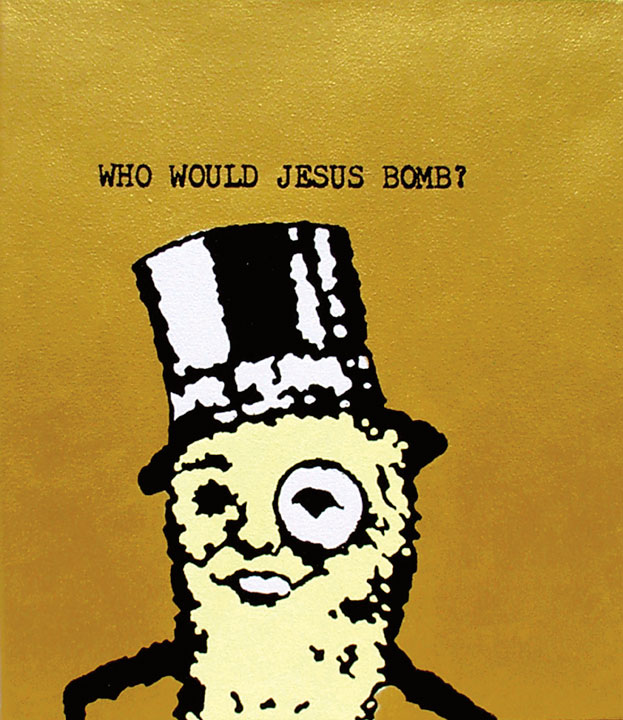
Clark Fox, “WHO WOULD JESUS BOMB”, 2005, acrylic on canvas, 12” x 14”